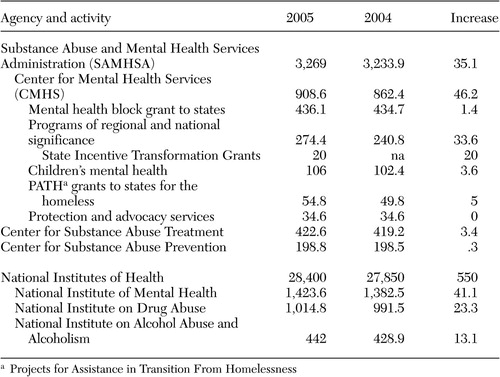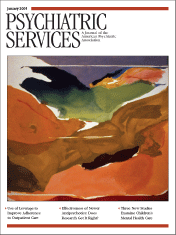CMHS Gains Largest Increase in 2005 Federal Mental Health Appropriations, NIH Budget Increased by Only 2 Percent
In December Congress passed an omnibus bill finalizing appropriations for federal health spending for fiscal year 2005. The Center for Mental Health Services (CMHS), which administers the state performance partnership block grants, children's services improvement grants, and a host of best-practice grants, received a $46 million increase over fiscal year 2004 (see Table 1).
CMHS will also administer the new State Incentive Transformation Grants, which award critical new federal dollars to states to begin realizing the vision of the New Freedom Commission on Mental Health. A total of $20 million was appropriated by Congress for these grants—less than half of the $44 million requested in the budget submitted to Congress by President Bush. Thus an additional $24 million will be needed to fund the grants at a level consistent with the Commission's agenda without taking money from other mental health priorities. Under the President's proposed budget, 14 states could receive grants in fiscal year 2005. In anticipation, some states have already formed commissions to develop plans to restructure crumbling public mental health systems into efficient, effective, and seamless service delivery systems for adults and children.
The overall increase for the National Institutes of Health (NIH) will be about $550 million—just 2 percent more than the appropriation for fiscal year 2004. The increase is the lowest in more than a decade for NIH, which has seen increases averaging 15 percent a year since 1998, when a bipartisan effort was launched to double the NIH budget. The small 2005 increases to the budgets of NIH's many institutes and centers will fail to keep pace with the biomedical research and development price index, projected at 3.5 percent.
WHO Releases Tenth Volume in Its Guidance Package on Mental Health Policies and Services
The World Health Organization's (WHO's) department of mental health and substance abuse has announced the release of the tenth volume in a series of 14 planned modules to enhance the development of mental health policy, planning, and services worldwide.
Like the other modules in the series, Child and Adolescent Mental Health Policies and Plans was developed by an international panel of experts to provide guidance on creating a comprehensive strategy to improve the mental health of populations by using existing resources to achieve the greatest possible benefits, providing effective services to persons in need, and assisting the reintegration of persons with mental disorders into all aspects of community life.
The aims of the latest module are to enable mental health authorities to develop and implement appropriate, evidence-based policies and plans for child and adolescent mental health; to inform responsible individuals of the unique challenges of working on behalf of these age groups; to share workable solutions to common problems; and to identify resources that offer additional tools or information.
Nine other volumes have been released since the series was launched in 2003:
Mental Health Context is an introductory module that describes the current global context of mental health, including the historical context and recent developments in the understanding, treatment, and care of people with mental disorders.
Mental Health Policy, Plans, and Programmes provides practical steps for developing and implementing policies, plans, and programs.
Planning and Budgeting to Deliver Services for Mental Health presents a rational planning model to assess the needs of local populations for mental health care and planning services.
Mental Health Financing gives guidance on assessing funding mechanisms, maximizing the resource base, and making best use of funds to promote mental health reforms.
Advocacy for Mental Health draws attention to the importance of advocacy in mental health policy and service development and describes practical steps to help state and local health authorities support advocacy.
Mental Health Legislation and Human Rights provides information for the development and implementation of mental health legislation.
Organization of Services for Mental Health describes the current forms of service organization and recommends an optimal mix to organize services.
Quality Improvement for Mental Health summarizes practical steps for the improvement of the quality of mental health care.
Improving Access and Use of Psychotropic Medicines gives guidance on improving access to and use of psychotropic medications. It addresses rational selection of drugs, affordability, sustainable financing, and availability of reliable health and supply systems.
Four modules are still in development: Mental Health Information Systems, Human Resources and Training, Research and Evaluation of Policy and Services, and Workplace Mental Health Policies and Programmes.
The modules, which are cross-referenced with each other, can be used individually or as a package to train mental health policy makers, planners, and providers; to provide a framework for technical consultancy; and to support advocacy. They contain useful information for public education and for increasing awareness about mental disorders and services among politicians, opinion makers, and the general public.
Each module is presented in a step-by-step format and includes practical examples. The guidance is not intended to be prescriptive—mental health authorities are encouraged to adapt the material in accordance with their own needs and circumstances. All the modules should be read in light of WHO's policy of providing most mental health care in community settings. The modules stress the importance of including consumer and family organizations in the development of policies and delivery of services.
The ten modules are available on the WHO Web site at www.who.int/mental_health/policy.
News Briefs
Mental Health, United States, 2002: The Center for Mental Health Services has released the latest edition of its compendium of reports based on current mental health statistics. The 390-page Mental Health, United States, 2002 includes 21 chapters organized into six sections: Looking Back, Looking Forward, Supporting Good Decision Making, Population Dynamics, Insurance for Mental Health Care, Status of Mental Health Services, and National Mental Health Statistics. Chapters report on a wide range of topics, including a CMHS-funded 16-state study of mental health performance measures; mental health in New York City after the September 11, 2001, terrorist attacks; the prevalence of parenthood among adults with serious mental illness; identification and treatment of attention-deficit hyperactivity disorder; employee assistance programs in 2002; and the size and characteristics of the current mental health workforce. The full text of the report is available on the Web site of CMHS's National Mental Health Information Center (www.mentalhealth.samhsa.gov).
AHRQ survey measures patient safety culture: The Agency for Healthcare Research and Quality (AHRQ) has released a new tool to help hospital and larger health systems evaluate employees' attitudes about patient safety in their facilities or within specific units. The Hospital Survey on Patient Safety Culture, which was released in partnership with Premier, Inc., the Department of Defense, and the American Hospital Association, addresses a critical aspect of patient safety improvement: measuring organizational conditions that can lead to adverse events and patient harm. Along with the survey and a 74-page user's guide, the package includes a feedback report template in which hospitals can enter collected data to produce customized reports for management and staff. The survey, which takes between ten and 15 minutes to complete, was pilot-tested with more than 1,400 employees at 21 U.S. hospitals. In January AHRQ will host a toll-free conference call to help health professionals implement the survey. The survey materials can be downloaded from the AHRQ Web site at www.ahrq.gov/qual/hospculture. Information about the January telephone conference will be published in the AHRQ electronic newsletter (www.ahrq.gov/news/ahrqlist.htm).
End-of-life planning videos: A set of two end-of-life planning DVDs—one version for families and one for critical care practitioners—originally released in 2001 has been rereleased by the Society of Critical Care Medicine (SCCM) to meet continued demand. The version for professionals addresses the difficult conversations critical care professionals must have with patients and family members as a means to improve end-of-life care. The program features a candid discussion of the complex psychological, emotional, and legal issues surrounding end-of-life care. The family version assists family members in helping their loved ones obtain the best and most appropriate care. It emphasizes the importance of communication among professionals, patients (when possible), and family members and addresses advance planning, communication with physicians, life-support withdrawal, pain and symptom management, and the goals of compassionate end-of-life care. The DVDs may be viewed at www.webcaststation.com. For additional information or to order, call SCCM customer service at (847) 827-6888.
 |
Table 1. Appropriations for federal mental health and substance abuse treatment programs for fiscal years 2005 and 2004, in millions of dollars



